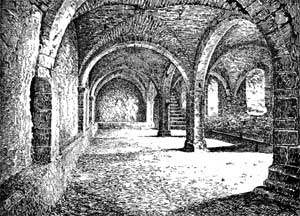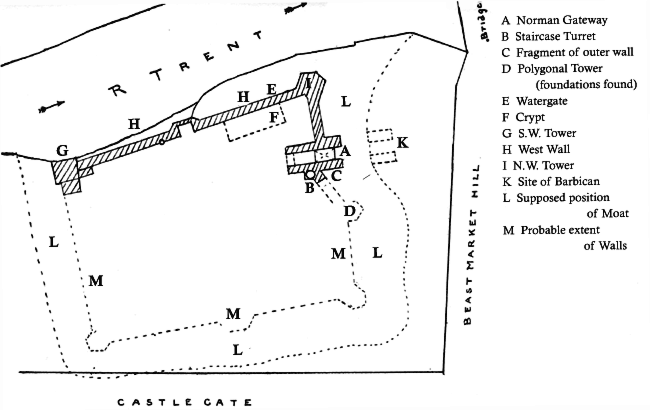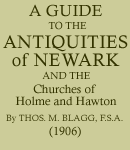< Previous | Contents | Next >

The Castle Crypt.
THE CRYPT.—The next portion in point of date is the interesting vaulted undercroft, or crypt. This fine chamber beneath the great hall of the Castle is four bays in length and two in width. The vaulting, which is of the plainest quadripartite character and without any ribs, is supported by a central arcade of four round-headed arches on three octagonal piers of obviously later date. The ends of the arcade and the eastern side of the vaulting are carried on pilaster responds of Norman character, while on the west wall the responds rest on corbels, one of which terminates in a single, another in a double, knot or twist. The west wall is pierced by four slits, widely splayed, which light the crypt, while a fifth lights a peculiar cell-like chamber on the north, probably, like the recess noticed in the main gateway, the cell or "sentry-box" in which sat the warder who had charge of the water-gate, through which came much of the Castle's supplies.
The steps forming the present entrance at the south end of the crypt are modern, the original entrance, now blocked up, being at the north-east corner, whence an inclined way, with flights of steps, debouched in the courtyard of the Castle, near the great gateway. This passage-way runs down past the north end of the crypt to the postern-gate, or water-gate, giving on to the river, which doubtless originally washed the base of the Castle wall. This gateway was secured both by doors fastened by a beam receding into the wall, as at the main entrance, and also by a portcullis, the slot for which will be noticed overhead. The chamber in which was the windlass for raising it can be seen in the wall above. This postern portcullis was the only one in the Castle, the great gate itself being secured by doors only, as has been seen. It is somewhat puzzling to assign a date to the crypt, but from the plain character of the vaulting and the pilaster responds, it most likely formed a part of Bishop Alexander's Castle, while the octagonal piers were possibly re-built (or perhaps re-placed timber posts) when the west wall was reconstructed in the thirteenth century.

Plan of Newark Castle.
THE SECOND PERIOD OF BUILDING.—Leaving the crypt we return to the terrace and immediately examine the evidences of this extensive reconstruction. Perhaps it was more a completion than a reconstruction. Firstly, because if Bishop Alexander had actually completed the whole of his Norman Castle on the massive and substantial lines of those parts of his work which have come down to us, it is scarcely conceivable that the fabric would require re-building only 150 years later; neither was it necessary for purposes of enlargement, for the position of the S.W. tower proves the Norman Castle to have covered the same area as the Edwardian. Secondly, when we remember that the Bishop did not begin to build the Castle until about the year 1130, and that in 1139 he was compelled to deliver it up to King Stephen, and that permanent possession of it was not recovered by its rightful owners until 1218, we see that it was scarcely possible for the entire Castle to have been finished on the ambitious lines of Alexander's plan during the space of only the nine years for which he held it. The great gateway, serving also as the keep, with its staircase turret, he completely finished, and also the S.W. tower, the greater part of the north wall, and the lower part of the west wall at its southern end. But it is possible that he had no time to build more than these still remaining structures, except the barbican (which would be necessary to protect his drawbridge), and to construct the great containing moat, which would be his first labour and would alone occupy a considerable time. If this was what happened, then the Castle in the reigns of Kings Stephen and John consisted of the parts we have mentioned, connected by earthen ramparts on the inner side of the moat (in itself a nearly sufficient defence for a strong garrison), crowned by a timber stockade. However this may have been, it is certain that some time after the Bishops of Lincoln recovered their Castle in the thirteenth century, building on an extensive scale was again begun on it. Bishop Alexander's materials seems to have been chiefly lias limestone rubble, or rag-stone, probably got from the adjacent parish of Coddington, with quoins, facings, and ashlar work generally of Ancaster or Haydor oolite, doubtless from the same quarries from which he built his castle at Sleaford.
The thirteenth century builders, while using or re-using the materials left by the Norman masons, drew their further supplies of dressed stone from the beds of "skerry" at Winkburn or Maplebeck. This mixture of materials gives a somewhat patchy appearance to the west face of the Castle. It is on the exterior of the north wall, perhaps, that the difference between the Norman stonework and that of the thirteenth century masons can be most strikingly seen.
THE WEST WALL.—The building of the West Wall then, of limestone within and sandstone without, was completed in the thirteenth century, the lower part of its southern end (as has been said) with its double latrine, the hooded shoots of which are conspicuous from the opposite bank of the river, having been constructed by the earlier masons. Near the south end, part of the parapet of this wall remains, showing the actual height. One of the merlons of the battlements is loop-holed, the others that remain are solid.
THE N.W. TOWER.—To this thirteenth century period belong the fine hexagonal north-west Tower, the similar tower in the middle of the west wall (which has a loop-holed chamber in its base, the entrance to which is unfortunately blocked up), and that portion of the north wall immediately adjacent to the N.W. tower.
THE GREAT HALL.—It was at this period that the great Hall of the Castle was erected. It appears to have occupied nearly two-thirds of the west front, being apparently 130 feet long, 22 feet wide, and 31 feet high. This hall was lighted by large pointed windows, probably on both sides, three of which in the west wall still remain. They appear to have been divided by mullions into three lights each, while the grooves till lately remaining in the sills showed that the side lights were fixed, while the centre one was an open casement. Portions of the upper tracery of these windows are shown in the earliest engraving we have of the Castle as being still in situ when that was published by Buck about 1720. On the interior of the north wall can be seen the weathering which indicates the height and pitch of the roof of this great hall, and the grooves in the west wall still remain, from which sprang the arched principals from long wall pieces built into the masonry— or possibly hammer-beams were the method of roof-support adopted.
In the fifteenth century the conditions of domestic architecture were changing from the feudal and baronial into the Tudor and residential type. The proportions of this fine hall with its vast open roof were destroyed, a floor divided it into two storeys, the hall itself was cut up into various rooms, and the large transomed windows of late Perpendicular date seen in the west wall were inserted.
